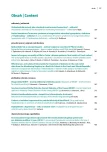Virilization as demonstration of hypertestosteronism by ovarian tumor: case report
Authors:
Michal Mokáň 1; František Nehaj 1; Juraj Sokol 2; Peter Vaňuga 3; Marián Mokáň 1
Authors‘ workplace:
I. interná klinika JLF UK a UNM, Martin, Slovenská republika
1; Klinika hematológie a transfuziológie, Národné centrum hemostázy a trombózy, JLF UK a UNM, Martin, Slovenská republika
2; Národný endokrinologický a diabetologický ústav, n. o., Ľubochňa, Slovenská republika
3
Published in:
Vnitř Lék 2018; 64(4): 437-440
Category:
Case Reports
Overview
Hypertestosteronism as part of hyperandrogenic states in women is generally defined as abundance of male hormones (in this case abundance of testosterone). Spectrum of clinical symptoms include menstrual disorders, amenorrhoea, different range of hirsutism and virilization. Statistically, most androgen secreting tumors are ovarian aetiology (testosterone secreting tumors located in suprarenal gland are very rare). This rare tumor may produce excess amounts of testosterone, as well as its precursor androstenedione. The highest incidence is between 20–40 years and in postmenopausal period. The treatment is essentially surgical; with gradual adjustment of the hormones.
Key words:
androgen secreting ovarian tumors – hyperandrogenic states – testosterone – virilisation
Sources
1. Markopoulos MC, Kassi E, Alexandraki KI et al. Hyperandrogenism after menopause. Eur J Endocrinol 2015; 172(2): R79-R91. Dostupné z DOI: <http://dx.doi.org/10.1530/EJE-14–0468>.
2. Stárka L, Dušková M. Androgeny a alopecie. DMEV 2005; 8(2): 75–78.
3. Stárka L. Syndromy necitlivosti na androgeny. DMEV 1999; 2(3): 128–132.
4. Dumic M, Simunic V, Ilic-Forko J et al. Extraovarian steroid cell tumor “not otherwise specified” as a rare cause of virilization in twelwe-year-old girl. DMEV 2000; 3(3): 210–211.
5. Rittmaster RS. Hirsutism. Lancet 1997; 349(9046): 191–195. Dostupné z DOI: <http://dx.doi.org/10.1016/S0140–6736(96)07252–2>.
6. Lazúrová I, Figurová J, Lazúrová Z. Diagnostika polycystických ovárií. Vnitř Lék 2015; 61(12 Suppl 5): 5S40–5S44.
7. Vrbíková J. Vrozená adrenální hyperplazie v dospělosti. Vnitř Lék 2016; 62(9 Suppl 3): 3S131–3S134.
8. Unluhizarci K, Kaltsas G, Kelestimur F. Non polycystic ovary syndrome-related endocrine disorders associated with hirsutism. Eur J Clin Invest 2012; 42(1): 86–94. Dostupné z DOI: <http://dx.doi.org/10.1111/j.1365–2362.2011.02550.x>.
9. Rothman MS, Wierman ME. How should postmenopausal androgenexcess be evaluated? Clin Endocrinol 2011; 75(2): 160–164. Dostupné z DOI: <http://dx.doi.org/10.1111/j.1365–2265.2011.04040.x>.
10. Markopoulos MC, Rizos D, Valsamakis G et al. Hyperandrogenism in women with polycystic ovary syndrome persists after menopause. J Clin Endocrinol Metab 2011; 96(3): 623–631. Dostupné z DOI: <http://dx.doi.org/10.1210/jc.2010–0130>.
Labels
Diabetology Endocrinology Internal medicineArticle was published in
Internal Medicine

2018 Issue 4
Most read in this issue
- Diagnosis of MODY – brief overview for clinical practice
- Cyclic Cushing’s syndrome: a case study and overview
- Virilization as demonstration of hypertestosteronism by ovarian tumor: case report
- Rare combination of Turner syndrome and congenital adrenal hyperplasia with 21-hydroxylase deficiency: case report
